Optimizing User Acquisition Campaigns: Effective Strategies and Tips
You’ve poured months or years into building your mobile game, but the real test comes when you want new players to download your game. With over 12,000 games launched annually, standing out in this industry is a significant challenge. Every install you earn counts, and every ad dollar you spend must deliver maximum impact.
Now, you can’t afford to guess what’s working. Players scroll in seconds and lose interest just as fast. If you’re aiming to scale your player base and climb the charts, you need clear strategies based on data and precision to acquire high-value users. One wrong move, and your ad spend burns without attracting the right players.
Are you also struggling with skyrocketing cost‑per‑install, unpredictable ad performance, or ads that just aren’t bringing in quality players? This blog provides actionable strategies and tips to optimize the UA campaign and achieve sustainable user growth effectively.
What is UA Campaign Optimization?
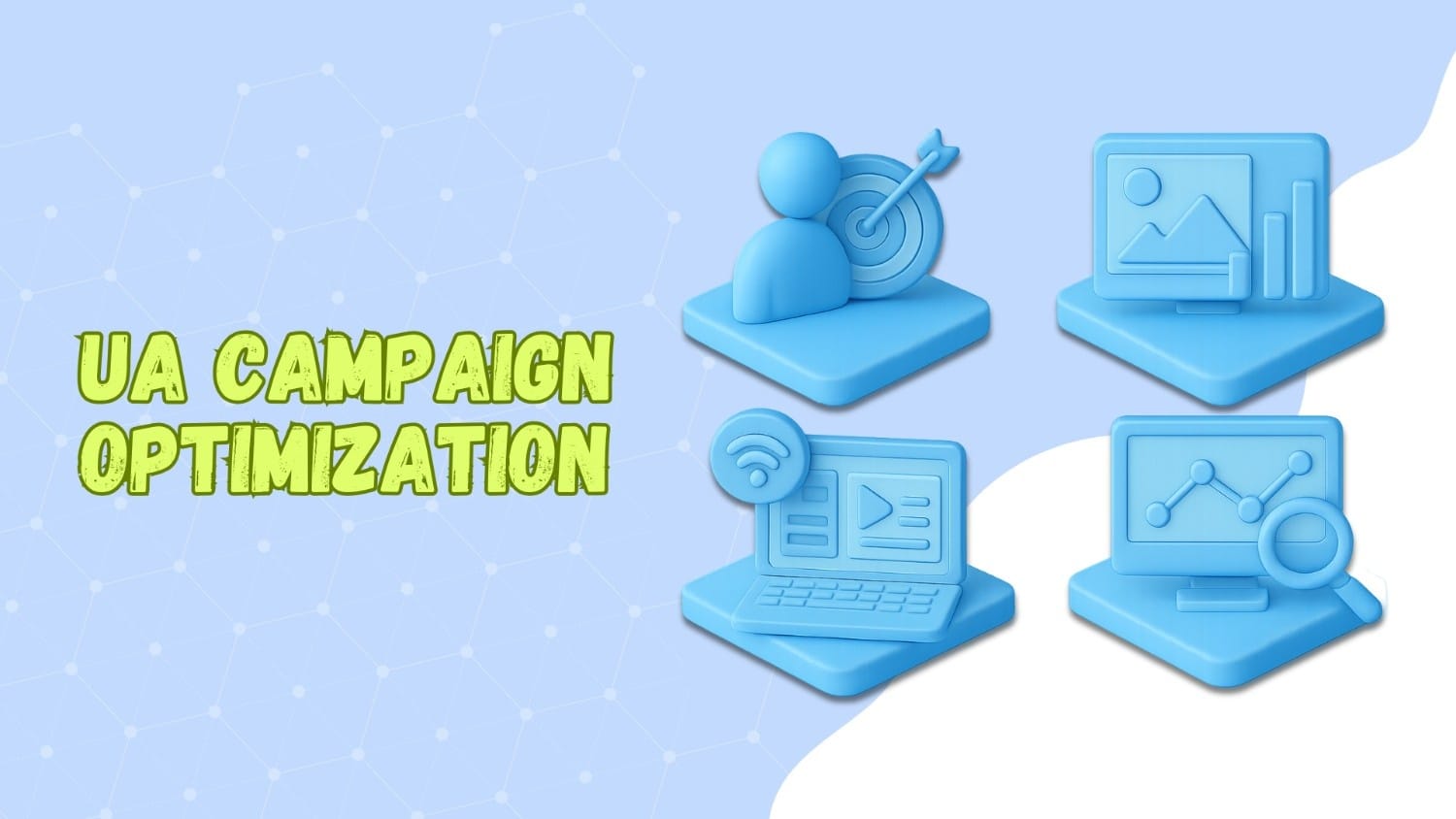
UA campaign optimization is the ongoing refinement of your ad strategy to attract high-quality players at the lowest possible cost. It means you’re not just attracting players to install your game; you’re investing in users who are likely to stick with your game. It involves:
Targeting the right audience: You want players who are likely to install and stick around. Utilize data-driven segments and lookalikes to target high-intent users.
Crafting compelling creatives: Your ads need to grab attention instantly; think bold visuals, immersive gameplay clips, and sharp messaging. A well-tested creative can dramatically improve click-through and install rates.
Selecting the best ad networks and platforms: Choose channels like TikTok, Meta, and ad networks where your ideal players spend their time or from where you acquire more players.
Continuous performance monitoring and adjustment: Track metrics like cost-per-install (CPI) and click-through rate (CTR). Use that data to tweak budgets, pause underperforming ads, and scale what’s working.
UA optimization keeps you focused on acquiring real players, not just downloads. It’s an iterative process to learn, adjust, and scale so every rupee you spend brings in players who matter.
Now that you know what UA campaign optimization means, let’s understand why it’s essential.
Why is Optimizing UA Campaigns Essential in Mobile Gaming?
User acquisition in mobile gaming isn’t just about volume; it’s about getting the right players at the proper cost. With rising competition and ad spending, optimizing your UA campaigns is the only way to grow. Here are the reasons:
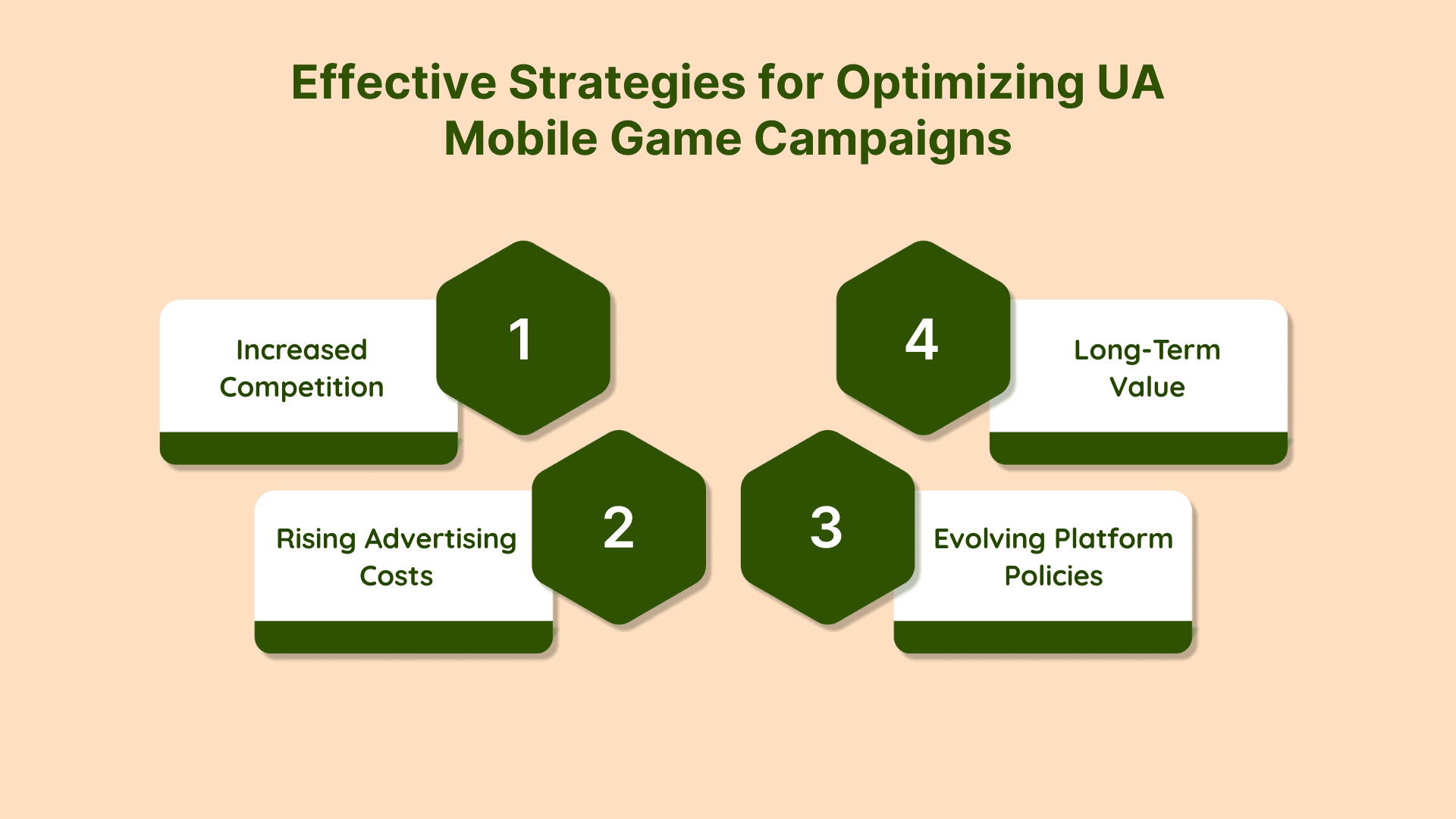
Increased Competition: You’re up against millions of other mobile games, all fighting for the same downloads. App stores are saturated, which means your ad strategy needs to cut through the noise and reach the players most likely to stick with your game.
Rising Advertising Costs: On average, CPIs have increased, reaching approximately $4.83 on iOS and $2.17 on Android for casual games in 2024. When ad dollars cost more, every install counts even more. You can’t afford to waste money.
Evolving Platform Policies: App store algorithms and user‑privacy standards are constantly changing (SKAN updates, ad tracking limits, shifting algorithm rules). Static tactics won’t survive; your UA campaigns must adapt to thrive.
Long-Term Value: By optimizing your UA campaigns, you lower CPI and also improve player lifetime value (LTV). That means acquiring players who will keep playing long after they install, making every ad dollar work harder for your game.
To consistently improve results and acquire high-quality players, you need strategies built for performance, not guesswork.
Effective Strategies for Optimizing UA Mobile Game Campaigns
To acquire high-quality players at scale, you need more than just ad spend; you need smart, data-driven strategies. These strategies enable you to attract the right users while maximizing every dollar.
Here are some proven tactics to optimize the UA campaign and consistently bring in players who engage from the very first touchpoint:
(Please add an infographic here)
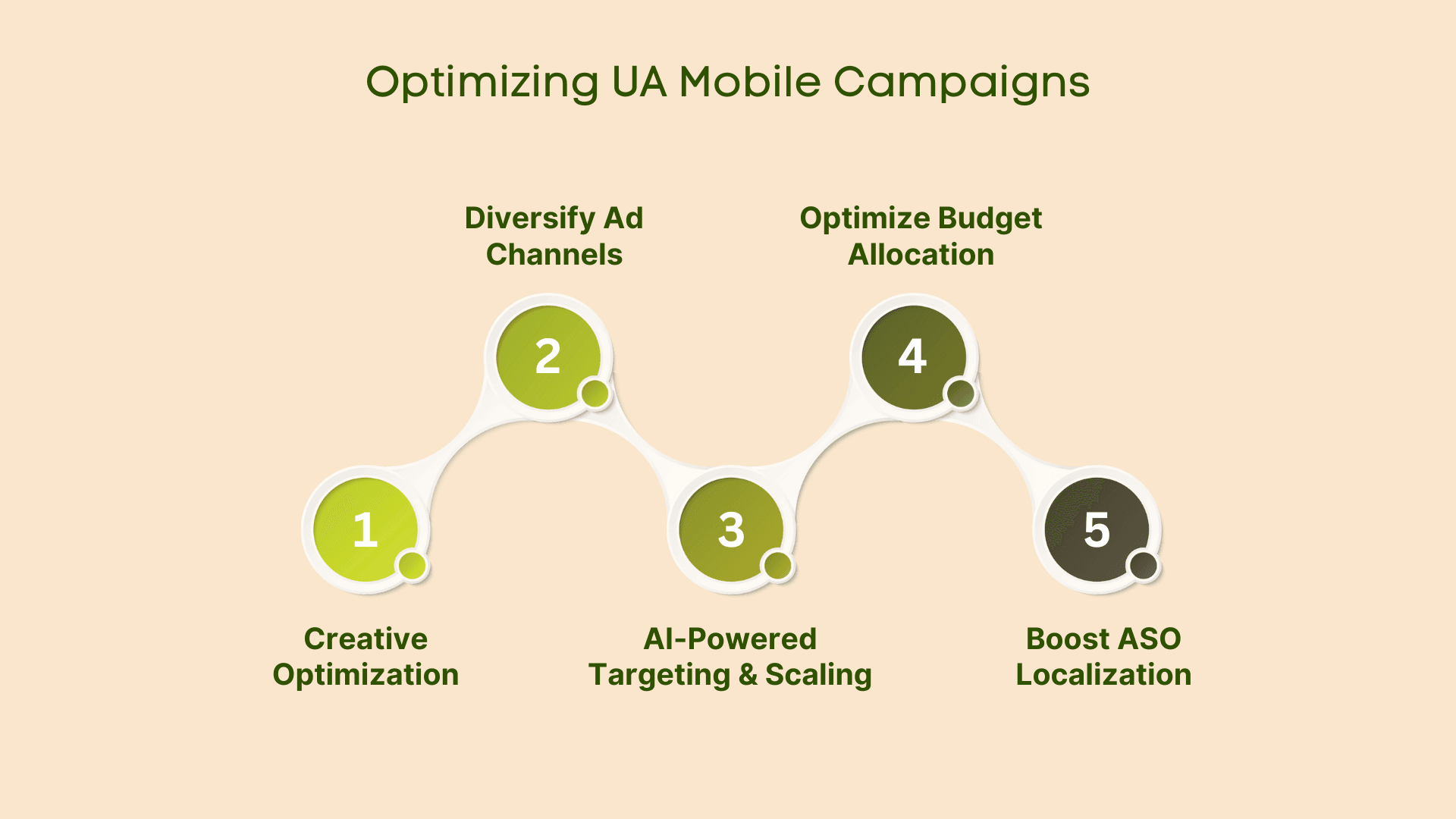
1. Focus on Creative Optimization
Creative optimization is the ongoing process of testing, refining, and enhancing your mobile game ads to maximize their impact. In user acquisition (UA) campaigns, your ad creatives are often the first point of contact between your game and a potential player.
From visuals and copy to interactive elements, every component influences whether a user clicks, installs, or scrolls through the content. Optimizing these elements ensures that you’re not only getting more installs but also attracting players who are genuinely interested in your game.
How It Optimizes Your UA Campaign and Attracts High‑Quality Players
Optimizing your UA campaigns through a disciplined, frequent creative testing and experimentation approach helps you attract and retain high-quality players by consistently identifying winning ad variations and staying ahead of market changes.
Regular Testing of New Creative Variables
Instead of relying on traditional, static A/B testing, it’s essential to introduce new creative variables, such as different visuals, messaging, calls-to-action, ad formats, and video lengths, at regular intervals, typically every 1-2 weeks. This rapid cycle of experimentation uncovers fresh insights, helps detect creative fatigue early, and prevents wasted ad spend on underperforming ads.
Multi-Phase, Data-Driven Testing Process
The testing process involves multiple stages rather than a simple dual-variant comparison:
Concept Exploration: Begin by testing several distinct creative concepts to identify the most effective themes and messaging that resonate with your target audience.
Refinement: Optimize the best-performing concepts by adjusting individual elements, such as CTA placement, pacing, or character focus, to enhance engagement.
Format Variations: Experiment with different ad formats, including playable ads, user-generated content, or interactive elements, to appeal to diverse player segments.
Scaling by Audience: Once winning creatives emerge, scale them thoughtfully by targeting specific demographics, regions, or player behaviors with tailored messaging.
Statistical Rigor for Confident Decisions
Allow your tests to gather sufficient data, often hundreds of installs per creative, to ensure the results are statistically meaningful. This reduces the risk of premature conclusions and helps allocate budget confidently to ads that consistently drive installs from engaged users.
Alignment with Long-Term Player Value
Craft your creatives to emphasize player behaviors aligned with campaign goals, such as retention milestones or lifetime value indicators. This ensures you’re not just acquiring installs but attracting players who are more likely to become loyal and monetizing users.
Agile, Collaborative Optimization
Frequent feedback loops between your user acquisition team and creative developers foster an agile environment. This collaboration enables quick adjustments based on performance data, keeping your campaigns responsive to platform shifts and evolving player preferences.
Want to Deep Dive Into the Exact Creative Testing Process?
For a comprehensive guide detailing step-by-step creative testing strategies, best practices, and common pitfalls, check out our Ultimate Guide to Creative Testing for Mobile Game User Acquisition. It’s packed with actionable insights to help you refine your UA creatives and scale your campaigns confidently.
2. Diversify Ad Channels
Diversifying ad channels means spreading your UA campaigns across multiple platforms and formats. Instead of relying solely on Facebook or Google, you intentionally use a blend of established and emerging channels. This balanced mix mitigates risk and keeps your game fresh and engaging.
How It Optimizes Your UA Campaign and Attracts High‑Quality Players
Multi-Platform Approach
You launch campaigns across platforms like Meta (Facebook/Instagram), TikTok, Google Ads, and leading ad networks, including Unity Ads, AppLovin, and ironSource. Each platform offers unique audiences and ad formats, e.g., short vertical videos on TikTok, interstitials on Unity, or search-driven ads via Google. By reaching users wherever they spend their time, you expand your potential installation pool and minimize your dependency on any single source.
Emerging Channels
You explore emerging platforms that resonate with gaming audiences, such as connected TV, or even Discord’s new mobile Video Quests, to amplify reach and freshness. For instance, Snapchat's AR lenses can create interactive, visually rich ad experiences for younger gamers. At the same time, CTV acts as a powerful top-of-funnel awareness driver that supports your core install-focused channels.
Cross‑Promotion
When you have multiple games in your portfolio or partner with other developers, you can advertise one game inside another via banner ads. This lets you reach players who have already shown interest in similar genres or mechanics. Since these users are pre‑qualified, you benefit from a higher conversion rate and lower CPI compared to cold traffic.
3. Combine Precision Targeting with AI-Driven Scaling
This strategy blends two powerful approaches, starting with laser-focused audience targeting and evolving into AI-powered campaign scaling. Initially, focus on identifying the types of users most likely to install and enjoy your game. Once you’ve pinpointed your high-performing segments, you use automated campaign tools powered by AI to scale your efforts efficiently and at a lower cost.
How It Optimizes Your UA Campaign and Attracts High‑Quality Players
Smart Segmented Targeting
In the early stages of launching your game, you don’t want to waste the budget on a broad, generic audience. Instead, set up small-scale campaigns that target specific demographics, such as age ranges, regions, device types, or gaming preferences.
For example, if your mobile game appeals to puzzle enthusiasts on Android devices aged 25–34, targeting them directly gives you clearer insights into performance. This phase lets you validate what works. You'll quickly learn which user segments are engaging with your ads, installing your game, and converting efficiently. It minimizes waste and ensures you attract players who are interested in your game mechanics and genre.
AI-Driven Scaling (Leverage Platform Intelligence)
Once you identify winning segments, it’s time to scale using AI-powered campaign tools, such as Google App Campaigns, Meta Advantage+, or TikTok Smart Performance Campaigns. These platforms use machine learning to analyze your best-performing users and then automatically target similar audiences, also known as lookalikes.
The AI continuously optimizes what creative is most effective, all based on performance data. This removes the guesswork, letting you focus on growth. You end up reaching more high-intent users without needing to manually tweak every detail.
4. Optimize Budget Allocation
Optimizing budget allocation means distributing your UA budget strategically based on performance data. Instead of spreading funds evenly across all channels, campaigns, or creatives, you adjust your spending dynamically, shifting more to top performers and pulling back on underperformers. The goal is to invest where you'll get the most installs at the best possible quality.
How It Optimizes Your UA Campaign and Attracts High-Quality Players
Data-Driven Decisions
You start by analyzing key UA metrics, CPI, install rate, and CTR, to determine what’s working. For example, if a campaign driving installs at a low CPI also delivers users with strong Day‑7 retention, you know it’s attracting players who enjoy and stay with your game.
You then funnel more budget toward those campaigns that provide both volume and quality installs. Segmenting users by predicted LTV using machine learning enables you to bid more to the users who are likely to stay and play longer, ensuring your investments bring invaluable players.
Flexible Budgeting
You don’t set and forget your budget on launch day. Instead, you adjust daily or weekly, pausing campaigns that aren’t delivering or shifting funds to ones that are outperforming. For example, if your search ad campaigns on Google are generating installs at half the CPI of your social ads, you can reallocate accordingly. You can also leverage dynamic CPI bidding, where costs automatically adjust based on your performance to maximize installs without overpaying.
5. Expand with ASO and Localization
This strategy combines two connected approaches: App Store Optimization (ASO) and localization. ASO improves your game's discoverability and appeal in app store search and listings. Localization adapts your game’s store presence to resonate with players in different regions. Together, they boost organic installs, enabling you to acquire new players.
How It Optimizes Your UA Campaign and Attracts High‑Quality Players
App Store Optimization (ASO)
ASO involves refining every aspect of your store listing to maximize visibility and conversion:
Titles, subtitles & keywords: Use relevant, medium, and long-tail keywords to capture niche search queries (e.g., "magical match‑3 puzzle") and improve organic ranking.
Visual assets (icons, screenshots, preview videos): Eye-catching visuals significantly influence install decisions; most users decide within 3–7 seconds. A/B test different icons and screenshots to see which converts best.
Ratings & Reviews: Encourage positive reviews and respond actively to feedback. Higher ratings improve visibility and build trust.
Through ASO, you attract players who are already searching for games like yours, bringing in high-intent users at low or no media cost.
Localized Marketing
Localization goes beyond simple translation; you culturally tailor your store presence for different regions:
Localized metadata and visuals: Translate titles, descriptions, and screenshot overlays; adapt imagery and design sensibilities to regional tastes.
Culturally nuanced content: Utilize keywords and visuals that resonate with local audiences. For example, use manga-style graphics for Japan or festive themes for local holidays.
Greater organic reach: Games with thorough localization often experience 120–200% more downloads in targeted non-English markets compared to those with basic translation only.
Localized listings enhance your conversion and rankings in non-English markets, allowing you to attract more players organically in new geographies.
Once you know what works, the next step is applying it with precision. Here's how to optimize your UA campaigns for better results.
Also Read: Creative Optimization in 2025: Dynamic Creative Optimization (DCO) Playbook for Mobile UA
How to Optimize UA Campaigns for Better Results
When you fine-tune your acquisition strategy with clear goals, data insights, and continuous experimentation, you’ll consistently drive more high‑quality installs. Here’s how to optimize your UA campaigns and bring in new players:
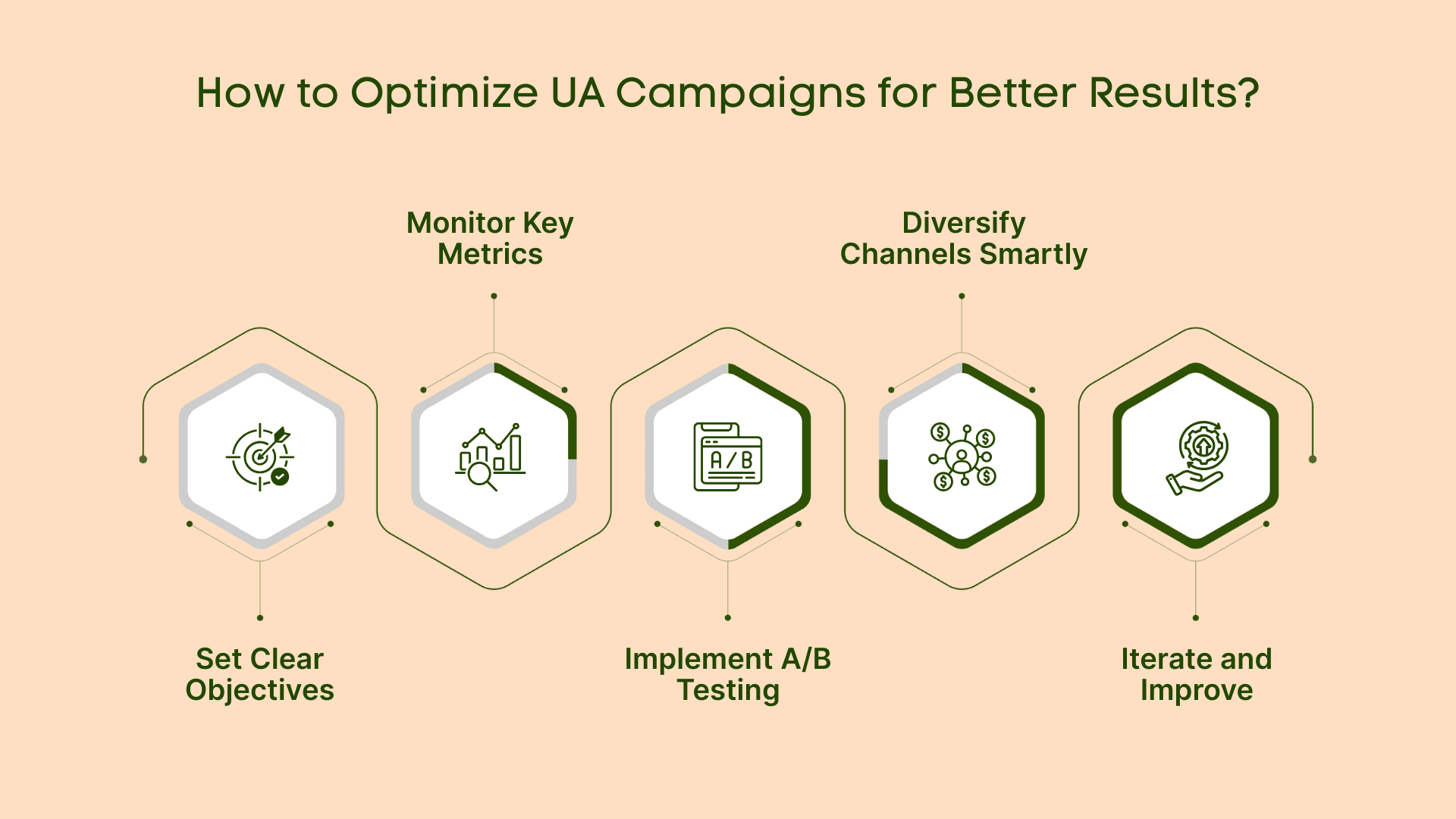
1. Set Clear Objectives
Before you launch any campaign, ask yourself: What exactly do I want to achieve? Do you want more installs, better ad views, or a lower cost per install (CPI)? When your goals are clear, it's easier to pick the right strategy. Without this step, you're just guessing, and that’s expensive.
2. Monitor Key Metrics
Track essential performance indicators, such as Cost Per Install (CPI), Lifetime Value (LTV), and install rate, to assess campaign effectiveness. To make data-driven decisions, you have to track the right numbers:
CPI tells you how much each installation costs
Install Rate shows the percentage of ad viewers who download
Lifetime Value (LTV) reveals how valuable each acquired player becomes over time.
Together, these KPIs let you evaluate whether you're not just acquiring new users but quality players worth your investment
3. Implement A/B Testing
Don’t run the same ad over and over. Conduct A/B tests to compare different ad creatives, targeting strategies, and messaging. Create two or three versions with minor changes, such as the headline, visuals, or call-to-action. Then, see which one performs better. Even small changes, such as using gameplay footage instead of a static image, can make a significant difference. This will identify the most effective elements and optimize campaigns accordingly.
For example, you might compare a high‑energy gameplay clip versus a character spotlight or test “Play Now” against “Join the Battle” in your call‑to‑action.
4. Diversify Channels Smartly
Allocating your entire ad budget to a single platform can limit your reach. Start with the ad channel that’s worked best for you so far. Once that’s running well, slowly test others, such as TikTok or programmatic ads. Compare the cost per install (CPI) across each platform to determine which ones yield the best results.
Tip: A good approach is to spend about 70% of your budget on channels that already perform well and use the remaining 30% to test new ones. That way, you can continue to grow while staying smart with your spending.
5. Iterate and Improve
Once you have results from your tests and data from your live campaigns, use those insights to fine-tune your approach. Optimization isn’t a one-time task; it’s a continuous loop. The more you iterate based on player behavior and performance data, the more efficient your campaigns will become in attracting high-quality players. Use insights from data and tests to iterate continuously:
Shift more of the budget to the ads and channels that are delivering the best results.
Refine messaging for audiences that underperform
Test new ad networks or DSPs after you’ve learned what works, so you can scale with confidence.
Once your core strategy is in place, a few simple tips can make your UA campaigns even more effective.
Essential Tips to Follow to Optimize UA Campaigns
Here are simple, actionable tips to bring in more players without wasting ad spend. Each one keeps your UA efforts sharp and effective:
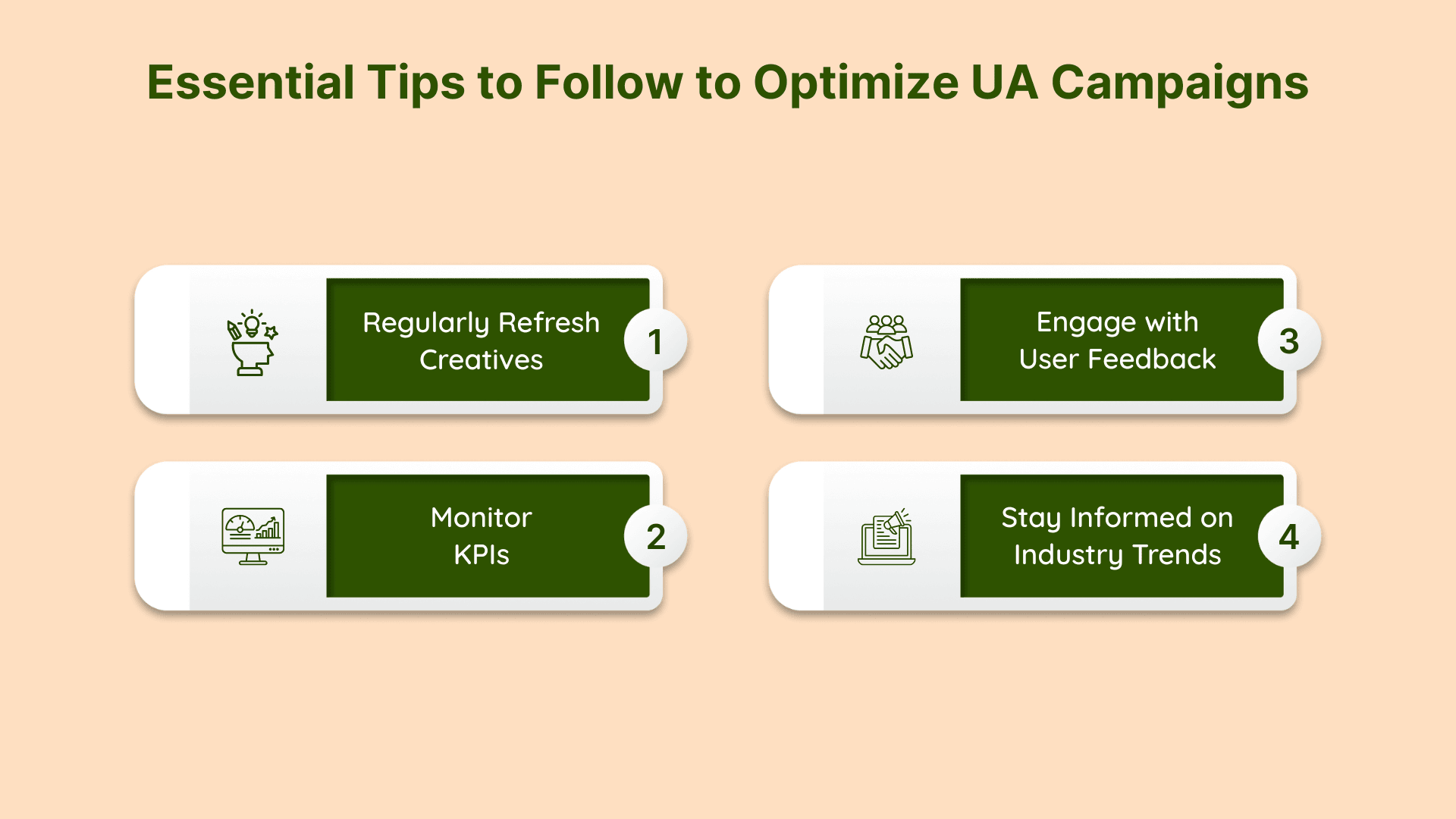
Regularly Refresh Creatives: Ad fatigue can hit quickly. If players see the same ad repeatedly, they are likely to scroll past it. Keep your ads fresh by updating visuals, formats, and copy regularly, every few weeks. Test new gameplay clips, different hooks, or alternative art styles to see what captures the most attention.
Monitor Key Performance Indicators (KPIs): Track core UA metrics like Cost Per Install (CPI), install rate, and conversion rate to gauge what's working and what's not. These numbers indicate which channels and ads are most effective in attracting new players.
Engage with User Feedback: Don’t ignore app store reviews or comments under ads. If players mention confusion or dislike about your creatives, address the issue. Responding to comments improves your game’s reputation and boosts its rating, which enables more players to discover your game.
Stay Informed on Industry Trends: User acquisition is constantly evolving, with new ad formats on TikTok and Meta, as well as changes in Apple’s SKAdNetwork and privacy rules. Continue learning about platform updates, shifting player behavior, and new ad formats to stay ahead and optimize strategies for acquiring new users.
Also Read: Emerging Trends in Creative Strategy: What’s Shaping the Future of Advertising?
Conclusion
Successfully acquiring high-quality players for your mobile game needs a proper strategy. From optimizing creatives and diversifying ad channels to refining your targeting and budget decisions, each step attracts high-quality players who are more likely to stick. When you combine data-driven insights with constant iteration, your UA campaigns become leaner, sharper, and far more effective.
That’s where Segwise comes in. With Creative AI Agent, Segwise automatically tags visual, text, and audio components in your ad creatives, across images, videos, and playable content, so you gain clarity on which elements, like character hooks or CTAs, are driving installs. Plus, Segwise’s AI-powered Campaign Monitoring Agent fetches and analyzes data from your MMP and ad networks in real-time, catching performance issues before they drain your budget.
So, are you ready to take your UA strategy to the next level? Start your 14‑day free trial today and scale your game with confidence.
FAQs
1. How can automation and AI enhance performance?
Use ML-powered tools to manage bids, budgets, targeting, and creative rotation. These systems enable real-time adjustments and efficiency across campaigns.
2. How frequently should I rotate creatives to avoid ad fatigue?
Monitor key indicators, including CTR, CPI, frequency, and ROAS. Swap or refresh creatives when the frequency rises or performance dips to prevent burnout.
3. How should I segment audiences for UA campaigns?
Segment by demographics, interests, behaviors, app usage, and other relevant factors. Analyze performance by segment and allocate budgets to those with the highest-quality users.
Comments
Your comment has been submitted successfully!